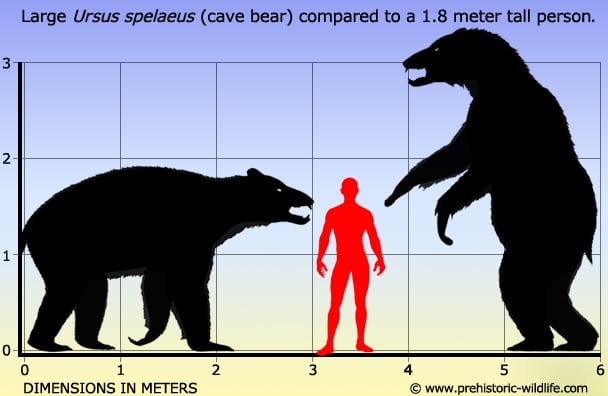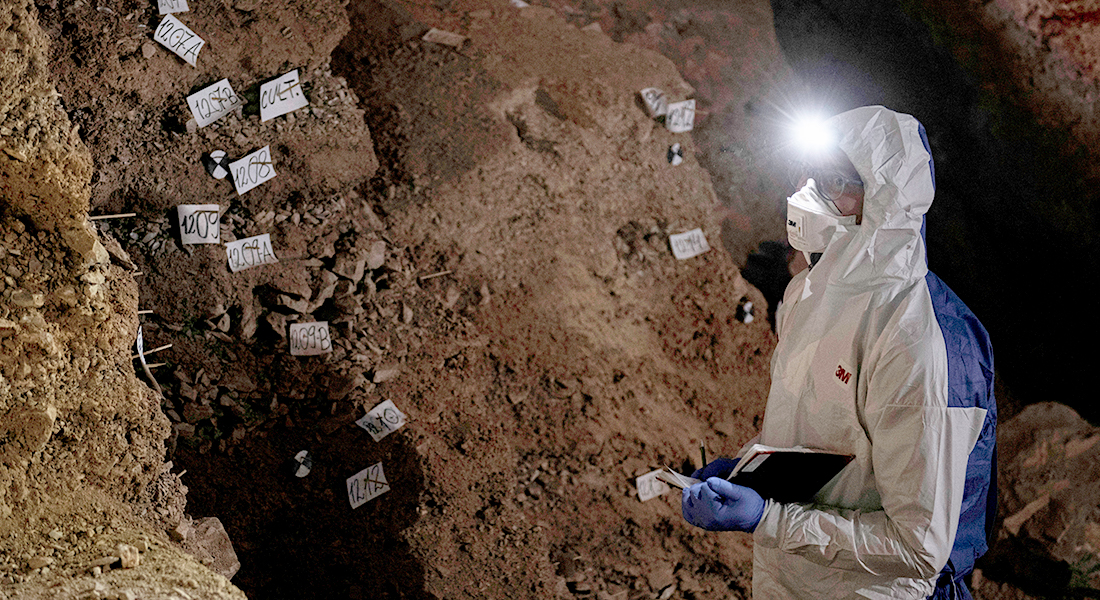Scientists have reconstructed the genomes of the extinct giant short-faced bear (Arctodus simus) and the American black bear (Ursus americanus) using environmental DNA fragments from the remote Chiquihuite Cave in Mexico.

Reconstruction of the giant, short-faced North American bear Arctodus simus. Image credit: Daniel Reed / CC BY-SA 3.0.
Fossil records are incomplete, and many species of mammals, in particular those that lived at low population densities, are seldom found.
For these ancient species, destructive DNA extraction from fossil remains has the potential to reveal new insights into population and evolutionary history; however, it also causes irreversible damage to high-value specimens.

The discovery that DNA from past populations of organisms could be obtained directly from sediment, therefore, held great promise for ancient population genetics and phylogenetics.
Commonly known as environmental DNA (eDNA) research, this approach relies on sequencing DNA fragments derived from shed cells, hair, feces, and urine preserved within sediment.
Standard eDNA techniques allow species composition to be determined in the absence of macrofossils across a variety of environments including sediments, cave formations, ice cores, lakes, rivers, and oceans.
To date, however, analyses of ancient eDNA have been restricted to mitochondrial and chloroplast DNA or, more recently, to short and highly diverse sequences generated using a shotgun sequencing approach.

“When an animal or a human urinates or defecates, cells from the organism are also excreted. And the DNA fragments from these cells are what we can detect in the soil samples,” said Professor Eske Willerslev, a researcher in the Department of Zoology at the University of Cambridge and the Lundbeck Foundation GeoGenetics Centre at the University of Copenhagen.
“Using extremely powerful sequencing techniques, we reconstructed genomes — genetic profiles — based on these fragments for the first time.”
“We have shown that hair, urine and feces all provide genetic material which, in the right conditions, can survive for much longer than 10,000 years.”
In the study, Professor Willerslev and his colleagues retrieved ancient genome-wide data from 16,000- to 14,000-year-old sediments in Chiquihuite Cave in Astillero Mountains, Mexico.
Their analysis shows that the Late Pleistocene black bear population in Mexico is ancestrally related to the present-day Eastern American black bear population, and that the extinct giant short-faced bears present in Mexico were deeply divergent from the earlier Beringian population.

“The short-faced bears that lived in northern Mexico were distinctly different from the population of black bears living in north-western Canada,” said Dr. Mikkel Winther Pedersen, a researcher in the Lundbeck Foundation GeoGenetics Centre at the GLOBE Institute at the University of Copenhagen.
“This is an excellent example of the new knowledge that suddenly becomes available when you reconstruct genomes based on eDNA fragments extracted from soil.”
“All over the world, everyone scientifically involved in the study of ancient DNA recognised the need to reconstruct genomes from fragments found in soil or sediment,” Professor Willerslev said.
“Being able to do that for the first time means we have opened up a new frontier.”
“Analysis of DNA found in soil could have the potential to expand the narrative about everything from the evolution of species to developments in climate change — this is the moon landing of genomics because fossils will no longer be needed.”
Source: sci.news








